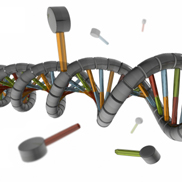
deoxyribonucleic acid / DNA
Deoxyribonucleic acid (DNA) is a molecule that encodes an organism's genetic blueprint. In other words, DNA contains all of the information required to build and maintain an organism. DNA was discovered in 1868, when twenty-four-year-old Swiss physician Friedrich Miescher isolated a compound from the nuclei of white blood cells. This compound was neither a protein nor a lipid nor a carbohydrate, so it was therefore a novel type of biological molecule. Miescher named his discovery "nuclein," because he had isolated it from the nuclei of cells. Today, this molecule is called DNA. Nearly all of the cells within a single organism include exactly the same DNA.
DNA is a linear molecule composed of four types of smaller chemical molecules called nucleotide bases: adenine (A), cytosine (C), guanine (G), and thymine (T). The order of these bases is called the DNA sequence. Segments of DNA that carry genetic information are called genes, and they are inherited by offspring from their parents during reproduction.
In 1953, Francis Crick and James Watson described the molecular shape of DNA as a "double helix." Double-stranded DNA is composed of two linear strands that run opposite to each other, known as anti-parallel strands; these strands twist together to form a double helix. The structure of DNA can also be described as a ladder. The chemical backbones of the ladder are made up of sugar and phosphate molecules that are connected by chemical bonds. The rungs of the ladder are pairs of units between A and T or between C and G. These pairs are called base pairs and they connect the two sugar-phosphate backbones through interactions called hydrogen bonds. In cells, the DNA helix is often overwound, causing a phenomenon known as supercoiling.
In the nucleus, DNA forms a complex with proteins. This complex is called chromatin and is formed when the DNA wraps around nuclear proteins and then wraps around itself multiple times to condense the DNA into a smaller volume. Additionally, DNA chromosomes are often recognized and depicted as X-shaped structures. DNA takes this form following DNA replication during the process of cell division, when replicated chromosomes are highly condensed and appear in an X shape.
Further Exploration
Concept Links for further exploration

















